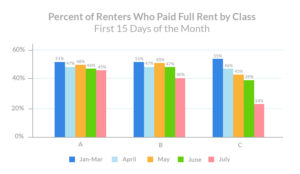Photo by Taber Andrew Bain via Flickr
385 Words
The COVID-19 pandemic endangers naturally occurring affordable housing.
In our last microblog, we highlighted the uncertainty surrounding the future of affordable housing development. But there’s a supply of existing affordable housing that often goes unnoticed.
Aging multifamily properties have been offering below-market rents to low- and moderate-income families for years without public subsidies. In 2016, CoStar estimated there are at least 5.5 million of these “naturally occurring” affordable housing, or NOAH, units, a significant portion of the nation’s affordable housing stock. But how are these already endangered properties faring amidst the uncertainty of the coronavirus pandemic?
NOAH residents struggle to pay rent…
LeaseLock, a nationwide lease insurance provider, recently highlighted the impact of the coronavirus pandemic on Class C rental properties within their nationwide portfolio.
According to LeaseLock, the share of renters that have been able to pay full rent within the first 15 days of the month has declined across all rental property classes since the pandemic began.
But Class C property residents have experienced the most dramatic decreases with only 24% of renters in July being able to pay— a 15-point drop from June. In July, only 37% of the total rent from Class C properties was paid by the end of the month.
…and NOAH landlords struggle to pay mortgages.
Bloomberg points to the possibility of foreclosure for many “mom and pop landlords” if residents continue to miss rent. While many of these properties have long been in danger of becoming market-rate, the pandemic has placed further pressure on a viable source of affordable housing.
For residents of NOAH properties, redevelopment or foreclosure could mean even greater hardships through displacement or homelessness. With the supply of affordable housing continuing to wane and future development facing uncertainty, the necessity of preserving existing NOAH is even greater.
How can existing NOAH be preserved?
Shelterforce highlights three funding models that support the preservation of NOAH properties through nonprofit and mission-driven developer acquisition. Meanwhile, the Richmond region, Miami-Dade County, and Metro Atlanta have collected best practices and strategies towards preservation. But before even thinking about funding and preservation in Virginia, localities and nonprofits need better data to understand the NOAH landscape here.
What properties are at risk of foreclosure or redevelopment? What resources do property owners need to maintain properties? Where are NOAH properties located?


